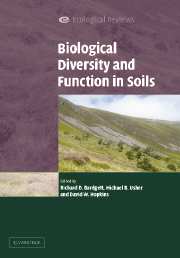Book contents
- Frontmatter
- Contents
- List of contributors
- Preface
- Acknowledgements
- PART I Introduction
- PART II The soil environment
- PART III Patterns and drivers of soil biodiversity
- PART IV Consequences of soil biodiversity
- 10 Microbial community composition and soil nitrogen cycling: is there really a connection?
- 11 Biodiversity of saprotrophic fungi in relation to their function: do fungi obey the rules?
- 12 Is diversity of mycorrhizal fungi important for ecosystem functioning?
- 13 Trophic structure and functional redundancy in soil communities
- 14 Plant–soil feedback and soil biodiversity affect the composition of plant communities
- 15 Response of the soil bacterial community to perturbation
- PART V Applications of soil biodiversity
- PART VI Conclusion
- Index
- References
10 - Microbial community composition and soil nitrogen cycling: is there really a connection?
Published online by Cambridge University Press: 17 September 2009
- Frontmatter
- Contents
- List of contributors
- Preface
- Acknowledgements
- PART I Introduction
- PART II The soil environment
- PART III Patterns and drivers of soil biodiversity
- PART IV Consequences of soil biodiversity
- 10 Microbial community composition and soil nitrogen cycling: is there really a connection?
- 11 Biodiversity of saprotrophic fungi in relation to their function: do fungi obey the rules?
- 12 Is diversity of mycorrhizal fungi important for ecosystem functioning?
- 13 Trophic structure and functional redundancy in soil communities
- 14 Plant–soil feedback and soil biodiversity affect the composition of plant communities
- 15 Response of the soil bacterial community to perturbation
- PART V Applications of soil biodiversity
- PART VI Conclusion
- Index
- References
Summary
SUMMARY
In the classical view of nitrogen cycling, the processes that involve nitrogen inputs and outputs (e.g. fixation, denitrification) are physiologically ‘narrow’ and so should be sensitive to microbial community composition, while internal turn-over (i.e. mineralisation, immobilisation) involves ‘aggregate’ processes that should be insensitive to microbial community composition.
A newly developing view of nitrogen cycling, however, identifies several ways in which mineralisation and immobilisation can be ‘disaggregated’ into individual components that may be sensitive to microbial community composition. Two of these are extracellular enzyme and microsite phenomena.
Exoenzymes are critical in driving decomposition, and hence mineralisation/immobilisation. Different classes of enzymes are produced by different groups of microorganisms. Additionally, the kinetics of exoenzymes may regulate microbial carbon and nitrogen limitation and hence community composition.
Microsite phenomena appear to regulate system-level nitrogen cycling (e.g. the occurrence of nitrification in nitrogen-poor soils), yet these effects scale non-linearly to the whole system. Different organisms may live and function in different types of microsites.
This new view of the nitrogen cycle provides an intellectual structure for developing research linking microbial populations and the nitrogen cycling processes they carry out.
Introduction
Since the days of Winogradsky and Beijerink in the late nineteenth century, nitrogen cycling has been at the centre of soil microbiology. Since then, we have largely deciphered the microbial physiology of the important nitrogen cycling processes and have identified some of the important microbial groups involved in them.
- Type
- Chapter
- Information
- Biological Diversity and Function in Soils , pp. 171 - 188Publisher: Cambridge University PressPrint publication year: 2005
References
- 40
- Cited by

